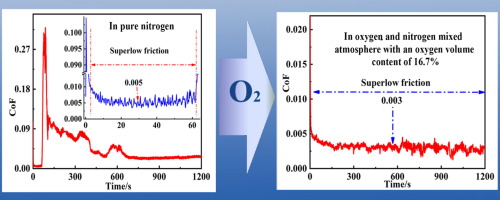Abstract
The achievement of superlow friction is vital for the engineering application of hydrogenated diamondlike carbon (H-DLC), but it always fails in an oxygen atmosphere. In this paper, robust superlow friction was achieved by MoS2 flakes and H-DLC composite films in a large range of atmospheres, especially in oxygen. The results showed that the composite structure could only retain the superlow friction for an short time in pure argon, nitrogen and carbon dioxide; surprisingly, oxygen was capable of remaining in the near frictionless state with a friction coefficient as low as 0.002, and the duration was prolonged significantly by the introduction of oxygen in those other gases. The stability of the transfer film that induced the near frictionless state was also studied comprehensively. The experimental results and first-principle calculations demonstrated that oxygen could bond with the molybdenum, sulfur and aluminum atoms to form bridge bonds that fixed the MoS2 transfer film on the counterface; this led to the formation of incommensurate contact between the MoS2 tribo-layer and H-DLC film, which enabled robust superlow friction. This finding supports a simple strategy to resolve the challenge of superlubric failure and opens a path for the actual application of H-DLC in oxygen-rich environments. (C) 2021 Elsevier Inc. All rights reserved.

KeyWords Plus:HYDROGENATED AMORPHOUS-CARBON; ULTRA-LOW FRICTION; SUPERLUBRICITY; GRAPHENE; WEAR; DLC; TRIBOCHEMISTRY; EVOLUTION; LUBRICITY; BEHAVIOR
Published in JOURNAL OF COLLOID AND INTERFACE SCIENCE,Volume 594;10.1016/j.jcis.2021.03.037,JUL 15 2021


